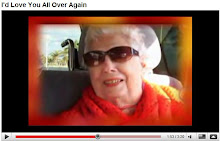The Other Health Care Crisis -- America's Elderly
By Martha Stewart for the The Huffington Post
As the health care bill winds its way through Congress, sparking passions, heated debate and countless news stories, I have been struck by the dearth of discussion about a looming health care crisis: In 2011, the first of 78 million baby boomers will start turning 65. We, as a nation, are utterly unprepared for this rapidly approaching "silver tsunami."
We do not have enough doctors skilled in the care of the very demographic group with the greatest overall health care needs. And we do not provide proper support for the more than 48 million men and women who, according to a recent report from the National Alliance for Caregiving, are caring for older family members and friends.
Our population is growing older and living longer. Life expectancy in the United States is at an all-time high of nearly 78 years. The oldest old, those who are age 85 and over, are the fastest growing segment of the population. Yet very few doctors are trained in the care of the elderly.
Do you know that there is currently one geriatrician to every 10,000 baby boomers? There are about three times as many cosmetic surgeons, a fact that speaks volumes about how we view aging in this country.
With the increase in the elderly population comes a concomitant increase in informal caregivers. Because around-the-clock home care runs as high as $150,000 per year (not including rent or food) and, depending on where you live, residence in an assisted living facility can easily cost $4,000 per month (none of which is covered by Medicare), more than 75 percent of Americans receiving long-term care rely solely on family and friends to provide assistance.
The vast majority of these caregivers are women, most of whom devote an average of 19 hours a week to their caregiving role, often while also holding down a paying job. Many are caring for young children and their aging parents at the same time. And many more, surveys show, have used all of their savings or cut back on their own health care spending in order to cover the cost of caregiving for their relative.
I come to these issues as the daughter of a woman who lived to the age of 93. My mother remained actively engaged in life and healthy nearly to the end. Still, we came to know first-hand some of the issues that need to be managed and the constant worry that shadows every day. What if she falls? What if she takes her medicine twice or, as was more likely with my mother, what if she decides not to take them at all?
My family's experience opened my eyes to the challenges facing countless Americans and their families, and inspired me to found the Martha Stewart Center for Living at the Mt. Sinai Medical Center in New York City. At the Center, which is dedicated to my mother, our mission is to help people live longer, healthier, productive lives even as they grow older. We also aim to develop new models of care for people over the age of 65 that will help our country and the world better meet the healthcare demands of an aging population.
There is an urgent need for innovative ideas and new paradigms -- and no quick fixes. But there are steps we can and should take. First, we must recognize that older adults are an idiosyncratic population with a broad spectrum of needs from the frail and fading Alzheimer's patient to the physically and mentally active senior like, for example, Clint Eastwood who at age 79 is arguably at the height of his creative powers. And we must educate doctors--whether or not they are geriatricians--so they can better understand and serve this demographic.
At Mt. Sinai [in NYC], every medical student is required to do at least some of their training at the Center for Living. No matter what specialty of medicine these doctors ultimately choose, they will be better prepared to work with our rapidly aging population.
Passage of the C.L.A.S.S. Act, a national long-term care insurance program that is currently part of both the House and Senate health care bills, could also make a difference. Introduced by the late Senator Edward M. Kennedy, the C.L.A.S.S. Act (short for Community Living Assistance Services and Support) would allow people to purchase long-term care insurance through payroll deductions and to receive cash to pay for home care, adult day programs, assisted living or nursing homes. The program's fiscal soundness has come under fire from certain quarters. There's no question that new legislation must be well-designed and viable over the long term, but, at the same time, we must not lose sight of a pressing need for solutions that will offer older adults and their families some financial protection.
We're all in this together. Whether or not you care about older people, you will, if you're lucky, be one of them. It's not just a demographic. It's personal -- it's you, your parents, your aunts, uncles, friends and children. We need to do a better job caring for this population -- and supporting those who care for them.
Martha Stewart is the founder of the Martha Stewart Center for Living at Mt. Sinai and Martha Stewart Living Omnimedia, Inc.
















3 comments:
The aim of the CLASS Act is not to create a new government entitlement program. It will be funded by the premiums of the participants (similar to Medicare Part B). And the $50 per day "average benefit" will only cover a small portion of the $60,000+ per year most Americans pay right now for in-home care. Most people who want to protect their savings will still need to purchase long term care insurance to supplement the CLASS Act benefit.
The biggest problem we face is that most Americans still think that Medicare or their medical insurance covers the cost of long term care. The CLASS Act addresses this problem by making a very clear statement: You have to pay for your own long term care. You either have to pay for your own long term care by using your savings, the $50 per day CLASS Act benefit, long term care insurance, or a combination of all three.
Most of the ten million Americans who own long term care insurance, own it because they've seen friends or family have to spend down their assets before qualifying for Medicaid. The CLASS Act will help alert the rest of the country to the fact that they need to financially plan for their future long term care needs.
Scott A. Olson
www.LTCInsuranceShopper.com
I have to clearly make two statements.
Why are people who never worked getting Medicaid to cover their nursing home expenses?
And..why not move the money from Medicaid that is covering these nursing home expenses into Medicare?
I am happy that you made this concept very clear in front of people and to be very frank this is useful info too. Thanks.caring for the elderly at home
Post a Comment